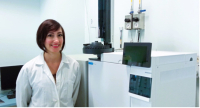
We started using the LECO PEGASUS® BT GC-TOF mainly for target analysis of aliphatic hydrocarbons on environmental matrices; over time we had the need to develop a method for the qualitative characterization of hop leaves samples for a research project, the ChromaTOF® deconvolution software allowed the identification of several compounds, in particular different terpenes. The Pegasus BT GC-TOF thus proved to be an excellent system, easy to use, with high sensitivity and reproducibility, able to perform both non target and target analysis.






